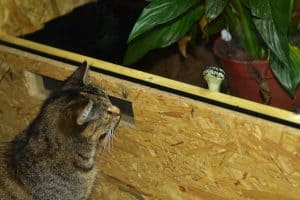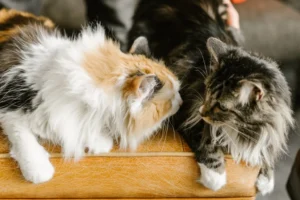Cats are mysterious creatures with incredible abilities, one of which is their exceptional night vision. But why exactly can cats see better in the dark?
Cats’ vision is optimized for low light conditions, allowing them to navigate and hunt effectively during the night. Let’s explore the fascinating reasons behind their superior night vision.
Evolution of Cats’ Night Vision
Cats’ exceptional ability to see in the dark can be attributed to their evolutionary history as efficient nocturnal predators. The ancestors of modern-day cats were primarily nocturnal hunters, relying on their vision to stalk and capture prey in low light conditions. This evolutionary trait has been passed down through generations, allowing domestic cats to navigate dimly lit environments with ease.
Structure of Cat Eyes
The unique anatomy of a cat’s eyes plays a crucial role in their superior night vision. One key feature is the tapetum lucidum, a reflective layer behind the retina that enhances light sensitivity. This layer reflects light back through the retina, giving the photoreceptor cells a second chance to detect and process light. Additionally, cats have vertical pupils that can open wide to allow more light into the eye, further enhancing their ability to see in low light conditions.
- Cats also have a higher concentration of rod cells in their retinas compared to humans, which are specialized for low-light vision.
- The elongated shape of a cat’s eye helps to create a wider field of vision, allowing them to detect movement and objects in the dark more effectively.
By understanding the evolutionary background and unique eye structure of cats, we can appreciate the remarkable night vision capabilities that make them such skilled hunters when the sun goes down.
Rods and Cones: The Key to Night Vision
Cats have a unique advantage when it comes to seeing in the dark – their eyes are equipped with a high number of rods, the light-sensitive cells responsible for night vision, compared to cones, which are responsible for color vision. This abundance of rods allows cats to detect even the slightest hint of light in low-light conditions, giving them the ability to navigate and hunt effectively in the dark.
Adaptations for Hunting at Night
In addition to having a high number of rods in their eyes, cats also possess specific adaptations that make them efficient nocturnal predators. One key adaptation is their heightened sensitivity to movement in dim light. This, combined with their excellent night vision, allows cats to easily detect and track prey in low-light environments, giving them a significant advantage when hunting at night.
Additional Insight: Enhance Your Cat’s Night Vision
- Provide low-light opportunities: Allow your cat to explore dimly lit areas to help them enhance their night vision capabilities.
- Avoid harsh lighting: Exposing your cat to bright lights for extended periods can hinder their ability to see well in the dark.
Comparison to Human Vision
While humans rely on cones in their retinas for color vision and detail during daylight, cats have a higher concentration of rods, specialized cells for low-light vision. Cats have a reflective layer behind their retinas called the tapetum lucidum, which bounces light back into the eye, giving them a “second chance” to absorb light. This extra boost enables them to see in light conditions as low as one-sixth of what a human needs. Additionally, cats’ pupils can dilate to cover nearly their entire eye, allowing them to capture more light and adjust quickly to changes in lighting. These differences in eye structure between cats and humans explain why our feline friends are such adept nocturnal hunters.
Training and Behavior
In addition to their unique eye structure, cats also exhibit behaviors that enhance their night vision capabilities. Cats’ slit-shaped pupils can expand wide to let in more light, helping them navigate in the dark more effectively. Their tapetum lucidum reflects light back through the retina, improving vision in dim lighting. This evolutionary adaptation has helped cats become efficient hunters, stalking prey under the cover of night. Furthermore, cats have a higher concentration of rod cells in their retinas than humans, allowing them to detect motion and track prey with precision in low light conditions. This combination of specialized eye features and instinctual behaviors makes cats excellent night vision predators.
Additional unique insight: – Cats’ whiskers can also contribute to their night vision. Known as vibrissae, these sensitive hairs help cats navigate in the dark by detecting nearby objects and changes in their environment. By brushing against surfaces, their whiskers provide tactile information that complements their exceptional night vision abilities.
Remember, the next time your cat effortlessly navigates a dark room, it’s not just magic – it’s a combination of remarkable biology and behavior at work.
Fun Facts About Cats and Darkness
Cats aren’t just mysterious creatures—they’re also masters of the night! Cats have exceptional night vision, thanks to their unique eye structure. While humans have about six to eight times fewer light-sensitive cells in their eyes than cats, felines boast a tapetum lucidum, a reflective layer behind their retina that boosts their night vision. This layer helps them see better in low light conditions and detect movement with remarkable accuracy.
When it’s lights out and you’re stumbling in the dark, remember to consider your feline friend’s well-being too. Install night lights in your home to help both you and your cat move around safely. Also, make sure to eliminate any potential hazards such as sharp objects, cords, or slippery surfaces that could pose a danger in the darkness. Providing a clear path for your cat ensures they can roam without any accidents.
- Place night lights strategically throughout your home to illuminate key areas.
- Keep pathways clear to prevent any tripping hazards.
- Avoid leaving small objects on the floor that your cat could ingest.
- Consider motion-activated lights for convenience and energy efficiency.
- Use rugs or mats to provide traction on slippery surfaces, reducing the risk of falls.
Remember, by following these tips, you can keep both you and your feline companion safe and sound during nighttime adventures.
Cat’s Night Vision in Popular Culture
Cats’ exceptional night vision has long fascinated humans, leading to their mystical and enigmatic portrayal in media and folklore. From ancient civilizations considering them as guardians of the underworld to modern-day depictions in movies and literature, cats’ ability to see in the dark has only added to their allure. Superstitions and myths often attribute supernatural powers to cats, further enhancing their mysterious reputation.
Folklore from various cultures around the world often depicts cats as creatures with a deep connection to the spirit world, able to navigate darkness with ease and grace. This portrayal reinforces the idea that cats possess a unique and otherworldly quality that sets them apart from other animals. In popular media, cats are often associated with magic, sorcery, and mystery, with their night vision serving as a key element in their portrayal.
Cats’ night vision is not just a physical trait but a symbol of their enigmatic nature, captivating human imagination for centuries. Through exploring the representation of cats in popular culture, we can gain a deeper understanding of the special bond between humans and these fascinating creatures.
With these insights into the captivating world of cats’ night vision, we can better appreciate the timeless allure and mystique that surrounds our feline friends. Their unique abilities make them stand out in the animal kingdom, cementing their status as beloved companions with a touch of magic.
Fun Fact: Cats have a reflective layer behind their retinas called the tapetum lucidum, which enhances their night vision by reflecting light back through their eyes. This layer is responsible for the glowing eyes cats often exhibit in the dark, adding to their mystical aura.
Why Cats Can See Better in the Dark
Cats’ remarkable ability to see in low light conditions stems from their unique anatomical features. Unlike humans, cats have more rod cells in their retinas, specialized photoreceptor cells that are highly sensitive to light and motion. This abundance of rod cells allows cats to gather and amplify even the smallest amount of light, enhancing their night vision significantly.
Additionally, cats’ eyes are equipped with a larger pupil and a wider iris, which enable more light to enter the eye. Their pupils can dilate to almost three times the size of humans’, further maximizing their night vision capabilities. Combine these adaptations with the tapetum lucidum, and cats become expert nocturnal hunters, able to see prey in near darkness with astounding clarity.
Furthermore, cats’ keen sense of hearing and smell complement their night vision, creating a comprehensive hunting package that makes them efficient predators. Their ability to navigate darkness effortlessly is not just a survival mechanism but also a testament to their evolution as hunters over thousands of years.
By understanding the biological reasons behind cats’ superior night vision, we can truly appreciate the marvel of nature that is our feline companions. Their unique adaptations make them not only fascinating creatures but also a source of wonder and admiration for cat lovers worldwide.
Alex, a passionate animal lover, has experience in training and understanding animal behavior. As a proud pet parent to two dogs and three cats, he founded AnimalReport.net to share insights from animal experts and expand his knowledge of the animal kingdom.









